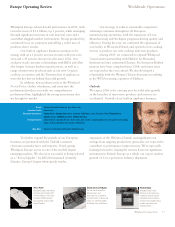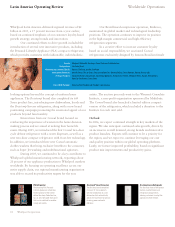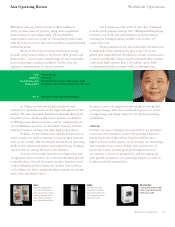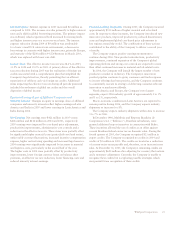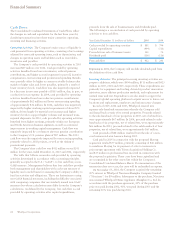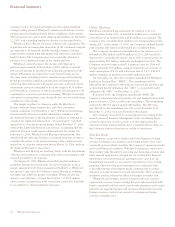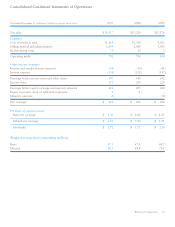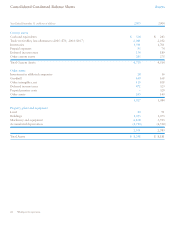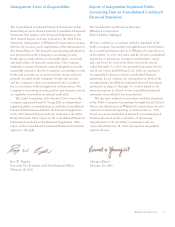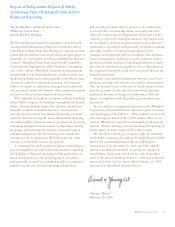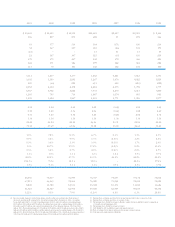Whirlpool 2005 Annual Report Download - page 30
Download and view the complete annual report
Please find page 30 of the 2005 Whirlpool annual report below. You can navigate through the pages in the report by either clicking on the pages listed below, or by using the keyword search tool below to find specific information within the annual report.26 Whirlpool Corporation
common stock to be issued will depend on the volume weighted
average trading prices of Whirlpool common stock during a twenty
trading day period ending shortly before completion of the merger.
The transaction was approved by Maytag shareholders on December
22
,
2005,
and is pending regulatory clearance as discussed below.
Whirlpool has sufficient resources to finance the acquisition. The
acquisition and upcoming debt maturities of the combined company
are expected to be financed initially through commercial paper
supported by existing bank agreements and with new committed
bank facilities. The Company expects to eventually refinance a
portion of its commercial paper in the capital markets.
Whirlpool currently expects the merger with Maytag to
generate approximately $300 million to $400 million of annual
pre-tax cost savings by the third year following completion of the
merger. Efficiencies are expected to come from all areas across
the value chain, including product manufacturing and marketing,
global procurement, logistics, infrastructure and support areas.
Achieving these efficiencies will require one-time costs and capital
investments currently estimated to be in the range of $350 million
to $500 million, a majority of which currently are anticipated to be
capitalized or accrued in purchase accounting. Whirlpool currently
anticipates incurring these costs during the first two years following
completion of the merger.
The merger is subject to clearance under the Hart-Scott-
Rodino Antitrust Improvements Act, and other customary
closing conditions. On December 1, 2005, Whirlpool and Maytag
announced that they had certified substantial compliance with
the Antitrust Division of the Department of Justice in response to
a request for additional information (“second request”) and had
agreed not to close the proposed merger before February 27, 2006,
without the Antitrust Division’s concurrence, recognizing that the
Antitrust Division could request additional time for review. On
February 13, 2006, Whirlpool and Maytag announced that they
agreed with the Antitrust Division to a limited extension of time to
complete the review of the proposed merger. The companies have
agreed not to close the transaction before March 30, 2006, without
the Antitrust Division’s concurrence.
Whirlpool and Maytag are working closely with the Department
of Justice and continue to cooperate fully with its investigation and
respond promptly to its inquiries.
On August 22, 2005, Whirlpool paid Maytag $40 million to
reimburse Maytag for its payment of a fee to terminate its prior
merger agreement with Triton Acquisition Holding Co. Whirlpool
has agreed to pay up to $15 million to assist Maytag in retaining
key employees while the merger is pending. Whirlpool also has
agreed to pay Maytag a “reverse break-up fee” of $120 million
under certain circumstances if the transaction cannot be closed due
to an inability to obtain regulatory clearance.
Other Matters
Whirlpool contributed approximately $15 million to its U.S.
pension plans during 2005, of which $13 million was a voluntary
contribution to its funded plans and $2 million was required. The
Company also contributed $25 million to its foreign pension plans
during 2005. At December 31, 2005, the Company’s defined benefit
pension plans still remain underfunded on a combined basis.
The Company recognized consolidated pre-tax pension cost of
$94 million, $91 million and $78 million in 2005, 2004 and 2003,
respectively. Consolidated pension cost in 2006 is anticipated to be
approximately $95 million, relatively unchanged from 2005. The
Company currently expects that U.S. pension costs for 2006 will
be approximately $72 million, using an expected rate of return on
assets assumption of 8.5% and a discount rate of 5.6%. The $72
million compares to pension cost of $66 million in 2005.
On November 14, 2005, the Company amended the Whirlpool
Employees Pension Plan (“WEPP”). The amendment will be
reflected in the Company’s 2006 pension cost and did not affect the
accumulated benefit obligation (the “ABO”) or projected benefit
obligation (the “PBO”) at December 31, 2005.
In January 2005, the Company amended the WEPP. The
Company remeasured the net periodic cost and funded status of the
plan at January 1, 2005, to reflect the amendment. The amendment
reduced the PBO by approximately $80 million. The ABO was
not affected by the amendment since the accrued benefits as of
December 31, 2005, were not affected by this change.
The Company is involved in various legal actions arising in the
normal course of business. Management, after considering legal
counsel’s evaluation of such actions, is of the opinion that the
outcome of these matters will not have a material adverse effect on
the Company’s financial position or results of operations.
Market Risk
The Company is exposed to market risk from changes in foreign
currency exchange rates, domestic and foreign interest rates, and
commodity prices, which can affect the Company’s operating results
and overall financial condition. Whirlpool manages its exposure to
these market risks through its operating and financing activities and,
when deemed appropriate, through the use of derivative financial
instruments. Derivative financial instruments are viewed as risk
management tools and are not used for speculation or for trading
purposes. Derivative financial instruments are contracted with
a diversified group of investment grade counterparties to reduce
exposure to nonperformance on such instruments. The Company’s
sensitivity analysis reflects the effects of changes in market risk.
Whirlpool uses foreign currency forward contracts, currency
options and currency swaps to hedge the price risk associated with
firmly committed and forecasted cross-border payments and receipts
related to its ongoing business and operational financing activities.
Foreign currency contracts are sensitive to changes in foreign
currency exchange rates.
Financial Summary



